Starting with these assumptions, we will develop a model that we can use to
account for the behaviour of simple circuits.
B. Compare the brightness of each of the bulbs in the two-bulb circuit
with that of a bulb in a single-bulb circuit.
Use the assumptions that we have made in developing our model for electric
current to answer the following questions.
- How does the current through the bulb in a single-bulb circuit compare
with the current through the same bulb when it is connected in series with a
second bulb? Explain.
The bulbs are much dimmer in the two bulb circuit. You have doubled the
resistance and halved the current
- What does your answer to question 1 imply about how current through the
battery in a single-bulb circuit compares to the current through the battery
in a two-bulb series circuit? Explain.
If the current through the bulbs is halved, the current through the battery
is also halved.
C. We may think of a bulb as presenting an impediment, or
resistance, to the current in the circuit.
- Thinking of the bulb in this way, would adding more bulbs in series cause
the total impediment to the flow, or total resistance, to increase, decrease,
or stay the same as before?
Adding more bulbs (resistors) in series increases the resistance.
Formulate a rule for predicting how the current through the battery would
change (i.e., whether it would increase, decrease, or remain the same) if the
number of bulbs connected in series were increased or decreased.
If the resistance of 1 bulb is R then the total resistance of n
bulbs in series is nR.
III. Batteries in Series
|
Using the 2 bulbs in series add an extra battery in series with the first so
that their voltages both act in the same direction. Draw the circuit you have
created.
A. Compare the brightness of the 2 light bulbs with 2 batteries in series
to their brightness with one battery only. Should the brightness of each bulb
in your 2 battery/2 bulb circuit be the same as in the 1 battery/1 bulb
circuit?
You have doubled the voltage and doubled the resistance; the current/brightness
of each bulb in the 2 battery/2 bulb circuit should be the same as in the
1 battery/1 bulb circuit.
B. Briefly connect the 2 batteries to a single light bulb. (Just touch the
terminal). What do you see?
With two batteries you have doubled the current and the voltage through a
single bulb, resulting in power (P = VI = I2R) 4X larger.
C. Turn one of the batteries around. What happens?
If the batteries have the same voltage the net potential difference across
the two batteries is zero; there will be no current.
| 
Batteries in series
|
IV. Bulbs and Batteries in Parallel
|
Set up a two-bulb circuit with identical bulbs so that their terminals are
connected together as shown. Bulbs connected together in this way are said
to be connected in parallel.
A. Compare the brightness of the bulbs in this circuit.
- What can you conclude from your observation about the amount of current
through each bulb?
The bulbs have the same brightness, thus carry the same current.
- Describe the current in the entire circuit. Base your answer on your
observations. In particular, how does the current through the battery seem
to divide and recombine at the junctions of the two parallel branches?
The current through the battery must be the sum of the currents through the
bulbs.
|
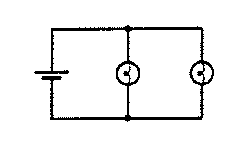
Two bulbs in parallel
|
B. Is the brightness of each bulb in the two-bulb parallel
circuit greater than, less than, or equal to that of a bulb in a
single-bulb circuit? Disconnect one bulb and check your answer.
The brightness (current, power) is the same.
- How does the amount of current through a battery connected to a single
bulb compare to the current through a battery connected to a two-bulb
parallel circuit? Explain, based on your observations.
The current through the two-bulb parallel circuit is twice the current
through a single bulb circuit.
C. Formulate a rule for predicting how the current through the
battery would change (i.e., whether it would increase, decrease,
or remain the same) if the number of bulbs connected in parallel
were increased or decreased. Base your answer on your observations of the
behavior of the two-bulb parallel circuit and the model for current.
The current through the battery increases as the number of bulbs connected
in parallel: n bulbs in parallel produces current nI compared
with a single bulb.
What can you infer about the total resistance of a circuit as the number of
parallel branches is increased or decreased?
Resistance for n parallel resistances will be R/n.
D. With both bulbs connected in parallel add a second battery in parallel.
Does this affect the brightness of the bulbs?
No, or hardly at all.
If the 2 batteries had slightly
different voltages (maybe one is a little flat) would you expect the bulbs to
change a little in brightness as the second battery is added?
If the second battery has a larger voltage, both bulbs will have this larger
p.d. across their terminals, thus higher current and will be brighter.
E. How would you compare the current through each battery with the
current through a single battery?
Each battery in parallel will have half the current of a single battery.
Would the 2 batteries in parallel be able
to light the bulbs for a longer period of time than a single battery?
Yep, twice as long.
V. More Complicated Circuits
A. The circuit at right contains three identical bulbs and a battery.
You may use 2 batteries in series to make a higher voltage. Connect and
disconnect a wire to act as a switch.
- Predict the relative brightness of the bulbs in the circuit with the
switch closed. Explain.
Swith closed is equivalent to B & C in parallel with the combined
resistance RBC in series with A. RA = 1R;
RBC = R/2. Total resistance = 1.5R. All current will flow
through A, then split between B and C. B and C will have half the current
and one-quarter (P=I2R) the power of A.
Predict how the brightness of bulb A changes when the switch is opened.
Explain.
With the switch closed no current will flow through C. All current goes
through A & B. Total resistance = 2R, so this circuit has smaller total
current than above (by 1.5/2.0 = 3/4). A and B will be fainter than A above,
brighter than B or C.
|
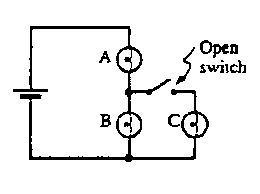
|
B. Predict the relative brightness of bulbs B1, B2, and B3 in the
circuits shown below. (A dashed box has been drawn around the network of
circuit elements that is in series with each of these bulbs.)
- What does your prediction imply about the relative current through the
batteries? Explain.
- In Circuit 1 total resistance R = 2R;
current through B1 is I1 = V/2R..
- In Circuit 2 total resistance R = 1.5R;
current through B2 is I2 = V/1.5.
- In Circuit 3 total resistance R = 3R;
current through B1 is I1 = V/3R.
B2 will be brightest, followed by B1, then B3.
Put together the circuits so that you can check your answers. Resolve
any conflicts between your answers and your observations.
| |
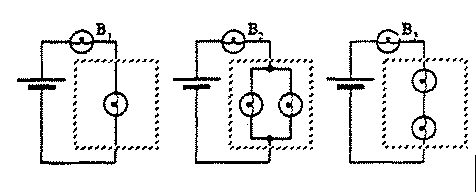
| |
C. Before setting up the circuit shown at right:
- Predict the ranking of the currents through the battery and each bulb
(iBat, i1, i2, and
i3). Explain.
In this case R1 = R and R23 = 2R. Bulb 1
will have twice the current of Bulbs 2 and 3 (which must have the same
current). The current through the battery will equal the sum of the currents
through Bulb 1 and Bulbs 2,3.
- i1 = 2 i2
- i1 = 2 i3
- iBat = 1.5 i1 = 3 i2.
Set up the circuit and check your predictions. If your observations and
measurements are not consistent with your predictions, resolve the
inconsistencies.
|
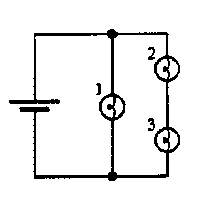
|

 Physics 1B Home
Physics 1B Home
 Tutorials
Tutorials
 Tutorial #6
Tutorial #6
 Tutorial #8
Tutorial #8
Gene Smith
Last
modified: Thurs., 18 May 2000


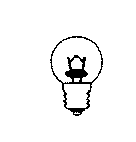
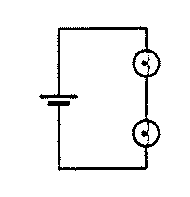






![]() Physics 1B Home
Physics 1B Home
![]() Tutorials
Tutorials
![]() Tutorial #6
Tutorial #6
![]() Tutorial #8
Tutorial #8